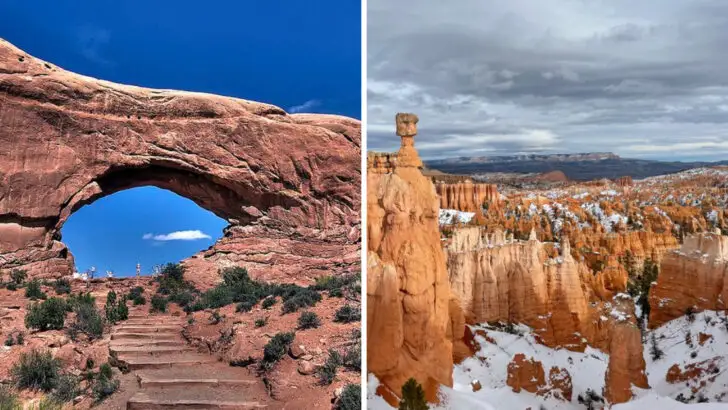Utah doesn’t do “average.” Its national parks are so dramatic, they look like they were carved by gods and painted by fire. But the real secret? Timing your visit just right turns a great trip into an unforgettable one. Each season brings its own kind of magic. Spring wakes up the desert with wildflowers and perfect hiking weather. Summer turns the canyons golden—but also tests your sunscreen’s limits. Fall wraps the red rocks in cool breezes and endless photo ops, while winter transforms everything into a quiet, snow-dusted wonderland.
There’s no bad time to go—just different adventures waiting at every turn. Whether you’re chasing sunrises in Arches, dodging crowds in Zion, or finding peace in Bryce Canyon’s silence, the best time to visit Utah’s national parks depends on what kind of story you want to tell when you come home.
Arches National Park
Arches National Park captivates visitors with its over 2,000 natural stone arches. Spring brings mild temperatures, making it ideal for hiking without the summer crowds.
From March to May, wildflowers bloom, adding splashes of color against the red rock. It’s a perfect time for photographers and nature enthusiasts.
Early mornings and late afternoons offer stunning light and fewer people, enhancing the park’s tranquility. Consider April for a blend of pleasant weather and visual beauty.
Zion National Park
Zion National Park transforms in autumn, offering a kaleidoscope of colors. The cottonwoods and maples turn gold and red, creating a vibrant tapestry.
September and October are ideal, with cooler temperatures and fewer tourists. The trails are more accessible, allowing for peaceful exploration.
Water levels in the Virgin River typically lower, making The Narrows hike safer and more enjoyable. Enjoy the crisp air and breathtaking vistas as the park reveals its autumnal splendor.
Bryce Canyon National Park
Bryce Canyon’s winter landscape is a sight to behold. Snow blankets the hoodoos, creating a striking contrast against the blue sky.
December through February offers a quieter experience, perfect for those seeking solitude. Snowshoeing and cross-country skiing add to the adventure.
The park’s elevation means cold temperatures, so dress warmly. Winter transforms Bryce into a magical wonderland, with its unique rock formations even more dazzling.
Capitol Reef National Park
Springtime breathes life into Capitol Reef’s orchards, with blossoms painting the landscape. March to May is perfect for witnessing this seasonal change.
The weather is cooler, making hikes through its rugged terrain more comfortable. Wildflower enthusiasts will be delighted by the variety of blooms.
The park’s remote location ensures a peaceful visit, ideal for photography and meditative walks amidst nature’s beauty. Explore the serene Fruita area and its historic orchards.
Canyonlands National Park
For those seeking solitude, late fall is the time to explore Canyonlands. The park’s vastness offers an escape, with breathtaking vistas in the cooler months.
October and November provide ideal temperatures for hiking, with less intense sun. The landscapes are striking under the soft autumn light.
Explore the Island in the Sky district for unforgettable sunrise views. The park is less crowded, allowing you to absorb its grandeur at your own pace.

